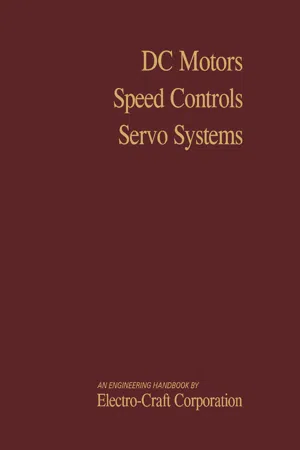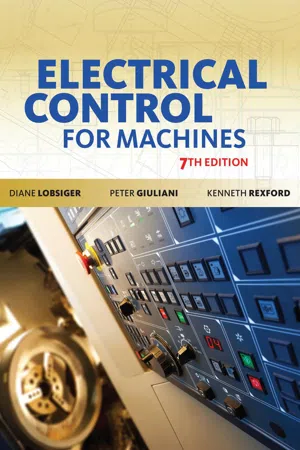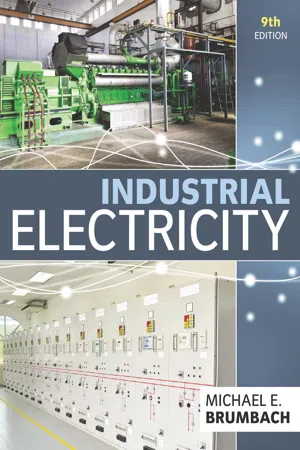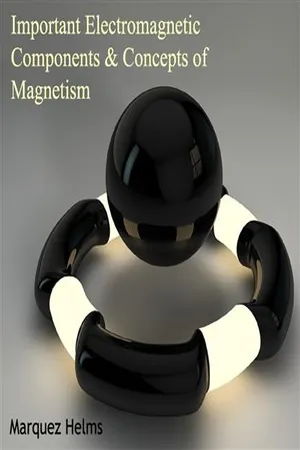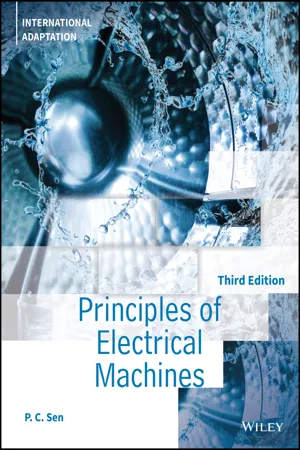Physics
DC Motors
DC motors are devices that convert electrical energy into mechanical motion. They operate based on the interaction between a magnetic field and current-carrying conductors, resulting in rotational motion. These motors are commonly used in various applications, including electric vehicles, industrial machinery, and robotics, due to their simplicity, reliability, and controllability.
Written by Perlego with AI-assistance
11 Key excerpts on "DC Motors"
- eBook - ePub
- John Chiasson(Author)
- 2022(Publication Date)
- Wiley(Publisher)
6 The Physics of the DC MotorThe principles of operation of a direct current (DC ) motor are presented based on fundamental concepts from electricity and magnetism contained in any basic physics course. In order to do this we review the concepts of magnetic fields, magnetic force, Faraday's law, and induced electromotive force s (emf s) as they apply to modeling the DC motor. All of the physics concepts referred to in this chapter are contained in the book Physics by Halliday and Resnick [18] .6.1 Magnetic Force
Motors work on the basic principle that magnetic fields produce forces on wires carrying a current. In fact, this experimental phenomenon is what is used to define the magnetic field. If one places a current carrying wire between the poles of a magnet as in Figure 6.1 , a force is exerted on the wire.Figure 6.1 Magnetic force law.Source: Adapted from Haber‐Schaim et al. [19] . PSSC Physics, 7th Edition, Kendall/Hunt, Dubuque, IA, 1991.Experimentally, the magnitude of this force is found to be proportional to both the amount of current in the wire and to the length of the wire that is between the poles of the magnet. That is, is proportional to . The direction of the magnetic field at any point is defined to be the direction that a small compass needle would point at that location. This direction is indicated by arrows in between the north and south poles in Figure 6.1 . With the direction of perpendicular to the wire, the strength (magnitude) of the magnetic induction field is defined to bewhere is the magnetic force, is the current, and is the length of wire perpendicular to the magnetic field carrying the current. That is, is the proportionality constant so that As illustrated in Figure 6.1 - eBook - PDF
DC Motors, Speed Controls, Servo Systems
An Engineering Handbook
- Sam Stuart(Author)
- 2013(Publication Date)
- Pergamon(Publisher)
Chapter 2 DC Motors and Generators 2.1. BASIC THEORY HISTORICAL BACKGROUND The direct current (DC) motor is one of the first machines devised to convert electrical power into mechanical power. Its origin can be traced to disc-type machines con-ceived and tested by Michael Faraday, the experimenter who formulated the funda-mental concepts of electromagnetism. Faraday's primitive design was quickly im-proved upon; and many DC machines were built in the 1880's when DC was the princi-pal form of electric power generation. With the advent of 60 Hz AC as the electric power standard in the United States and 50 Hz in Europe, and invention of the in-duction motor with its lower manufacturing costs, the DC machine became less impor-tant. In recent years, the use of DC ma-chines has become almost exclusively asso-ciated with applications where the unique characteristics of the DC motor (e.g., high starting torque for traction motor applica-tion) justify its cost, or where portable equipment must be run from a DC (or battery) power supply. The ease with which the DC motor lends itself to speed control has long been recog-nized. Compatibility with the new thyristor (SCR) and transistor amplifiers, plus better performance due to the availability of new improved materials in magnets, brushes and epoxies, has also revitalized interest in DC machines. The need for new high-perfor-mance motors with highly sophisticated capabilities has produced a superabundance of new shapes and sizes quite unlike DC machines of 10 years ago. CONCEPT OF TORQUE AND POWER An understanding of electro-mechanical energy conversion, as exemplified by a motor, is based upon acquaintance with several fundamental concepts from the field of mechanics. The first concept is that of torque. If a force is applied to a lever which is free to pivot about a fixed point, the lever, unless restrained, will rotate. - eBook - PDF
- Diane Lobsiger, , , (Authors)
- 2021(Publication Date)
- Cengage Learning EMEA(Publisher)
188 13 CHAPTER OBJECTIVES After studying this chapter, you should be able to: Motors and Drives 13.1 DC Motors—Principles of Operation Motors produce work by using electrical energy to cause motion. When electricity is supplied to a motor, a shaft begins to rotate. If the shaft is cou-pled to a mechanical load, work will be performed by moving the load. Motors operate based on the principle of electromagnetism . That is, when a cur-rent is passed through a conductor a magnetic field is created. When the current flow is stopped, the magnetic field will collapse. The strength of the magnetic field will be increased if the conductor is looped into a coil configuration, if the amount of current is increased, if the number of turns or coils is increased, or an iron core is placed in the center of the loop. Motors utilize all of these factors to in-crease the magnetic field and to control the motor. Consider the diagram, shown in Figure 13-1, to illustrate the basic principle of operation for a DC motor. In this example, a single loop of wire is attached to a commutator to form a simplified armature. The commutator is two half circles that are constructed from copper. The brushes are spring loaded and sit against the commutator as it rotates. The contact between the brushes and the commutator allow a path for current to flow from • Name the important components of a DC motor • Explain the principles of operation for a DC motor • Know the basic types of DC Motors • Explain the characteristics of each type of DC motor • Describe the basic operation of a DC drive • Explain the principles of operation for an AC motor • Name the important components of an induction motor. • Explain slip and its importance in the operation of a three-phase induction motor. • Describe the basic operation of a variable frequency drive (VFD) • Explain the major difference between a polyphase motor and a single-phase motor. - eBook - PDF
- Michael Brumbach(Author)
- 2016(Publication Date)
- Cengage Learning EMEA(Publisher)
330 330 C H A P T E R 17 DC Motors O B J E C T I V E S After studying this chapter, the student will be able to: ■ Explain the principles upon which DC Motors operate. ■ Describe the construction of DC Motors. ■ Discuss the different types of DC Motors and their operating characteristics. ■ Describe basic motor maintenance procedures. The electric motor utilizes electrical energy and magnetic energy to produce mechanical energy. The purpose of a motor is to produce a rotating force (torque). The basic construction of a DC motor is very similar to that of a DC generator. Each has a frame, end bells, field poles, an armature, and a commutator. There is, however, a vast difference in their use and operation. A generator is driven by some type of mechanical machine (steam or water turbine, gasoline engine, or electric motor). It requires mechanical energy for its operation. The goal is to convert mechanical energy into electrical energy. A motor, in contrast, requires electrical energy for its operation. An electric current flowing through the motor windings causes the armature to rotate. The goal is to produce mechanical motion, thus converting electrical energy into mechanical energy. Copyright 2017 Cengage Learning. All Rights Reserved. May not be copied, scanned, or duplicated, in whole or in part. Due to electronic rights, some third party content may be suppressed from the eBook and/or eChapter(s). Editorial review has deemed that any suppressed content does not materially affect the overall learning experience. Cengage Learning reserves the right to remove additional content at any time if subsequent rights restrictions require it. DC Motors 331 A single-loop motor does not produce a steady torque, nor is it practical. In order to construct a motor that will develop a reasonably steady and us-able torque, it is necessary to have many coils on the armature. The armature now becomes a practical electromagnet with a north pole and a south pole. - eBook - PDF
Electricity and Electronics for Renewable Energy Technology
An Introduction
- Ahmad Hemami(Author)
- 2017(Publication Date)
- CRC Press(Publisher)
141 DC Motors and Generators OBJECTIVES: After studying this chapter, you will be able to • Define a magnetic field • Differentiate between a magnet and an electromagnet • Determine poles of an electromagnet • Express fundamentals of DC electric motors • Explain Lorentz force • Understand components of a DC machine and the importance of each one • Define the characteristic curve for the performance of a machine • Explain similarity between a DC motor and a DC generator • Describe Faraday’s law in electricity • Describe the difference between various types of DC Motors • Understand the use of different DC Motors for different applications • Understand the rules of batteries in series and in parallel • Explain the conditions to put DC generators in parallel together • Define rated value(s) for an electric machine • Describe what efficiency is • Explain why efficiency can never be 100 percent • Calculate the efficiency of a motor 7.1 Introduction One of the properties of electricity is magnetism. All motors work based on this property of electricity and its effects, as you will see in this chapter and Chapter 11. This chapter covers the fundamentals of DC machines. The reason why the term “machine” is used here is that the basic construc-tion of a motor and a generator, particularly for DC electricity, is the same. A machine can be used as a generator (converting mechanical energy to electrical energy) or a motor (converting electrical energy to mechanical energy). There are many different types of motors, particularly in AC electric-ity, but in this book we discuss only the construction of major motors, because the variety in structure and physical differences can give different properties for the operation of a motor. - No longer available |Learn more
- (Author)
- 2014(Publication Date)
- Learning Press(Publisher)
In a DC motor this power is supplied to the armature directly from a DC source, while in an induction motor this power is induced in the rotating device. An induction motor is sometimes called a rotating transformer because the stator (stationary part) is essentially the primary side of the transformer and the rotor (rotating part) is the secondary side. Induction motors are widely used, especially polyphase induction motors, which are often used in industrial drives. Electrostatic motor (capacitor motor) An electrostatic motor or capacitor motor is a type of electric motor based on the attraction and repulsion of electric charge. Usually, electrostatic motors are the dual of conventional coil-based motors. They typically require a high voltage power supply, although very small motors employ lower voltages. Conventional electric motors instead employ magnetic attraction and repulsion, and require high current at low voltages. In the 1750s, the first electrostatic motors were developed by Benjamin Franklin and Andrew Gordon. Today the electrostatic motor finds frequent use in micro-mechanical (MEMS) systems where their drive voltages are below 100 volts, and where moving, charged plates are far easier to fabricate than coils and iron cores. Also, the molecular machinery which runs living cells is often based on linear and rotary electrostatic motors. ________________________ WORLD TECHNOLOGIES ________________________ DC Motors A DC motor is designed to run on DC electric power. Two examples of pure DC designs are Michael Faraday's homopolar motor (which is uncommon), and the ball bearing motor, which is (so far) a novelty. By far the most common DC motor types are the brushed and brushless types, which use internal and external commutation respectively to create an oscillating AC current from the DC source—so they are not purely DC machines in a strict sense. - eBook - ePub
Electrical Machine Drives
Fundamental Basics and Practice
- Claiton Moro Franchi(Author)
- 2019(Publication Date)
- CRC Press(Publisher)
Figure 1.3 shows a typical DC motor.FIGURE 1.1Three-phase induction electric motor.FIGURE 1.2Electric motor types.The DC Motors can be divided into two main magnetic structures:FIGURE 1.3DC motor. (Courtesy of Weg.)Stator: Composed of a ferromagnetic structure with salient poles where there are coils placed that form the magnetic field. Typically, two windings are placed in the stator: the series field, consisting of a small number of turns with larger cross section coil wire, and the shunt field, made by a large number of coils with smaller cross section, as shown in Figure 1.4 .The magnetic field can also be produced by permanent magnets with this type of machine application restricted to applications of small power, such as toys, hot blowers, computer disc drives, etc.Rotor: Is an electromagnet composed of an iron core with windings connected to a mechanical system called a commutator. The commutator is along with the rotor shaft and has a cylindrical surface with blades that are connected to the rotor windings and with brushes that are pressed together with these blades and connected to the power supply. The commutator has the function of transforming DC into AC in a suitable way for motor torque development.FIGURE 1.4Series and shunt field in a stator.FIGURE 1.5Stator and rotor integrated in a 2 poles DC motor.Figure 1.5 shows the stator and rotor integrated in a two-pole DC motor.The DC motor can be divided into two distinct circuits: armature (rotor) and field (stator). In this analysis, it will be considered a motor powered by two voltage supplies: one for the armature circuit (Ua ) and one for the field circuit (Uf ), as shown in Figure 1.6 - J. David Irwin, David V. Kerns, Jr.(Authors)
- 2022(Publication Date)
- Wiley(Publisher)
CHAPTER 14 DC Machines LEARNING OBJECTIVES • To learn that when the machine is operated as a motor, the input is electrical and the output is mechanical • To learn that when the machine is operated as a generator, the input is mechanical and the output is electrical • To understand that motor operation is based upon the fact that a force is produced on a current-carrying conductor when moving in a magnetic field • To understand that generator operation is based upon the fact that a voltage is induced in a conductor when moving in a magnetic field • To explore the various components of a dc machine and learn their function in machine operation • To learn how to model dc machine operation and various machine configurations INTRODUCTION In this chapter, we discuss the fundamentals and some applications of dc machines. First, we describe the basic physical principles that govern their operation. We then show how these con- cepts can be employed to construct a dc machine. The equivalent circuits for DC Motors and generators are presented and analyzed to exhibit some of their operating characteristics. Finally, we describe some applications demonstrating the use of dc machines in industry. A LINEAR MACHINE Perhaps the easiest method of describing the fundamentals that govern the operation of a dc machine is to first examine what is called a linear machine. A simple linear machine is shown in Figure 14.1. In this figure, a voltage source is connected through a switch to a pair of electrical conducting rails. A conducting bar, which makes electrical contact with the rails, is free to move along the rails in the x direction. The rails and bar are present in a constant magnetic B field that is directed into the page, that is, in the negative z direction. Let us now examine the operation of this machine in three separate time intervals, that is, t < t 0 , t = t 0 , and t > t 0 . During the time period t < t 0 , the switch is open.- P. C. Sen(Author)
- 2023(Publication Date)
- Wiley(Publisher)
A wide variety of volt–ampere or torque–speed characteristics can be obtained from various connections of the field windings. Although a dc machine can operate as either a generator or a motor, at present its use as a generator is limited because of the widespread use of ac power. The dc machine is extensively used as a motor in industry. Its speed can be controlled over a wide range with relative ease. Large DC Motors (in tens or hundreds of horsepower) are used in machine tools, printing presses, conveyors, fans, pumps, hoists, cranes, paper mills, textile mills, rolling mills, and so forth. Additionally, DC Motors still dominate as traction motors used in transit cars and loco-motives. Small dc machines (in fractional horsepower rating) are used primarily as control devices—such as tachogenerators for speed sensing and servomotors for positioning and tracking. The dc machine definitely plays an important role in industry. 5.2.1 Construction In a dc machine, the armature winding is placed on the rotor and the field windings are placed on the stator. The essential features of a two-pole dc machine are shown in Fig. 5.10. The stator has salient poles that are excited by one or more field windings, called shunt field windings and series field windings. The field windings produce an air gap flux distribution that is symmetrical about the pole axis (also called the field axis, direct axis, or d-axis). The voltage induced in the turns of the armature winding is alternating. A commutator–brush combination is used as a mechanical rectifier to make the armature terminal voltage unidirectional and also to make the mmf wave, due to the armature current fixed in space. The brushes are so placed that when the sides of an armature turn (or coil) pass through the middle of the region between field poles, the current through it changes direction. This makes all the conductors under one pole carry current in one direction.- eBook - PDF
- Irving Gottlieb(Author)
- 1997(Publication Date)
- Newnes(Publisher)
Response is enhanced because the windings remain energized, greatly reduc- ing the effect of their inductive time constants. Fig. 2.9 The DC watthourmeter-a contrarian DC shunt motor. This archaic instrument is a basic shunt motor. Yet, its behaviour is opposite that of conventional DC shunt motors. Resolution of this paradox provides instruc- tive insight into motor operation. Practical aspects of DC Motors 51 , i i i, l, ii i i, i i , i . . . . . . . . . . . . . . . . . . . . . . . . . . . . . . . . . . . . . . shunt field, the armature voltage increases. In rum, this results in greater speed. The eddy-current disc provides a retarding torque such that rotational speed is directly proportional to the power expended in the load. Incident- ally, the armature current is not constant with respect to voltage variations from the DC source. If, for example, this voltage should increase, higher armature current would result. In turn, higher speed would be developed, which represents the increased power in the load. Finally, the revolution counter reads out the integrated value of this power with respect to time which is usually in kilowatt-hours of electrical energy. The DC series motor The DC series motor is one of the traditional 'work-horses' of electro- mechanical energy conversion. Its popularity with railway, automobile, and other traction applications largely stems from the very high torque develop- ed by this motor at standstill and at low speeds. The torque is high because armature current flows through both, the armature and the series field giving rise to an exceptionally-strong magnetic field between the armature con- ductors and the pole faces. The motor obligingly supplies greater torque in response to shaft loading until a limit is imposed because of magnetic saturation. The older control method via a series-connected resistance was naturally very wasteful of energy-it sufficed for trams, but is unacceptable for electric automobiles. - Saeed Benjamin Niku, Saeed Benjamin(Authors)
- 2022(Publication Date)
- Springer(Publisher)
6.12. BACK-EMF IN DC Motors: SERVOMOTORS 185 6.12 BACK-EMF IN DC Motors: SERVOMOTORS Back-emf plays a significant role in the performance of all motors, but especially DC Motors. To understand this issue first recall our discussion about the relationship between an applied torque, mass moment of inertia, and angular acceleration as described by Equation (5.16), repeated here: T = Ia As we discussed, when a torque is applied to a rotating body, it accelerates and rotates faster in proportion to its mass moment of inertia. As long as the torque is present and exceeds friction and other resistive torques, the body will continue to accelerate and rotate faster. Now consider a DC motor that is connected to a battery. As the current flows through the motor and the electromotive force exerts a torque on the rotor, it will start to rotate. In proportion to the mass moment of inertia of the rotor, it will continue to accelerate and rotate faster as long as the torque is present (and of course, for lighter rotors, the acceleration is higher and vice versa). However, since this torque continues to be present, should we not expect to see the rotor's speed continue to increase, theoretically to infinity? In other words, while the current continues, so does the torque and the acceleration, increasing the angular velocity indefinitely until the rotor disintegrates. But we know from experience that if we connect a motor to a battery, when it reaches its nominal value, the velocity no longer increases. Why? This is due to the same back-emf. Once again, let's imagine that we connect a DC motor to a battery. Since there is a torque, the rotor accelerates and its angular velocity increases. However, as mentioned before, since the rotor contains coils that are moving in the presence of a magnetic field, a back-emf voltage (or current) is induced in the coil which is in the opposite direction of the supplied current.
Index pages curate the most relevant extracts from our library of academic textbooks. They’ve been created using an in-house natural language model (NLM), each adding context and meaning to key research topics.

